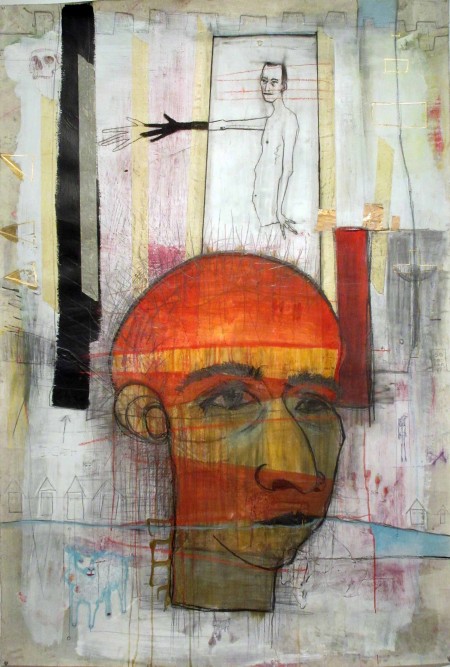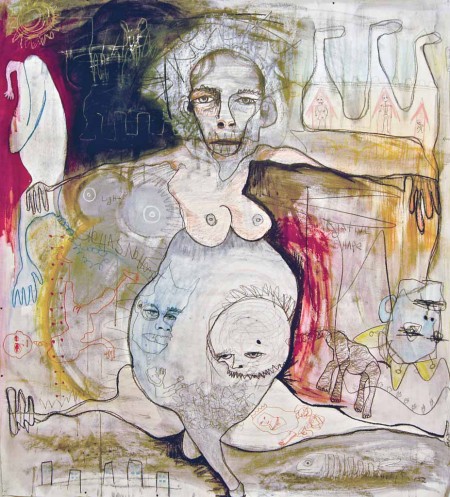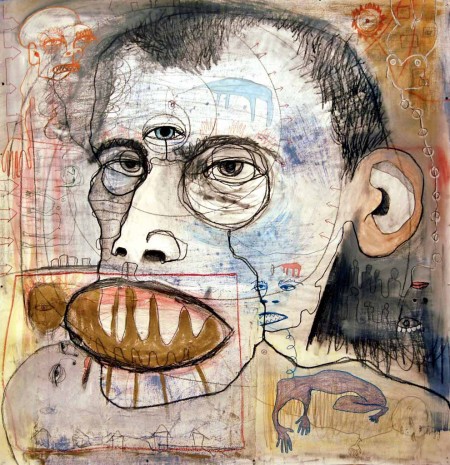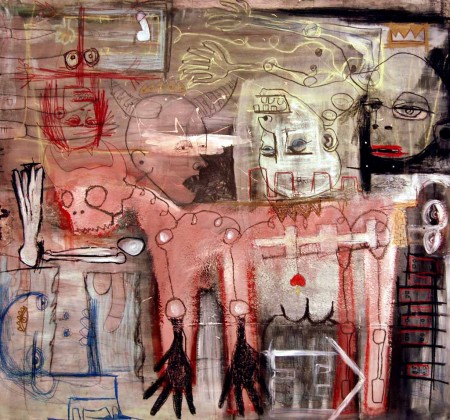The job of the artist is to always deepen the mystery – Francis Bacon
The large scale mixed media pieces on paper by Andy Fausz are not for the faint of heart. They are brutally honest and beautifully rendered. To many they may be shocking, but shock is not the intent of the work, which bumps up carefully against graffiti art. In these dark dreamlike compositions, Fausz’s examines the pain of a disrupted relationship, and the struggle between evil and good, and life and death. These are works that entice you to look closely due to the artist’s masterful use of color, composition, line and rhythm, but the experience is much like watching a Hitchcock classic with your hands over your eyes, afraid of what might appear next. A dozen large works on paper, created between 2009 and 20ll, are in this exhibit at the Philip M. Meyers Jr. Memorial Galley at DAAP. They are unframed and hang freely, which intensifies their physical impact. Each piece is composed of layer upon layer of drawn and painted imagery. Fausz’s compositions are complex and enigmatic, but quickly a very powerful personal language appears. Skulls, portions of skeletons, black hands, heads with horns, heads on springs, heads with crowns, heads with a third eye, mouths that are tight lipped, vagina dentatae, stiff four legged beasts, vapid birds, angry fish, electric outlets, rows of small houses, rows of churches, rows of flowers, rows of knives, exposed male and female figures, fluffy lambs, Christ crucified and the Sacred Heart are all recurring images coupled with ever present self-portraits.
In Death Sheep, 2009, 7’h x 4’w, a very gaunt, lanky male figure, likely the artist, outlined in heavy charcoal and reminiscent of Egon Schiele’s expressionist nudes, extends a blackened arm towards a very delicate and beautifully drawn rendering of a human skull. Behind this central figure a ghostly drawing of the almost invisible Christ, crucified,hovers. A thick black band borders the left side of the work. At the bottom, a sheep, outlined in cotton candy blue with bright red lips, stands in front of a row of childlike drawn houses. Above the houses the very faint word DEATH points to the black band. The whole work is dominated by a bright orange, tightlipped, prickly self-portrait which looks towards a very small drawing of a skeleton hanging from the gallows.
Another of the earlier works, Exposed, 2009, 5h’ x 5w, also includes this tight lipped visage of the artist at the top center of the composition with a very large left ear, which recurs in other works. This head, drawn in charcoal, is perched above a female body, arms and legs extended outwards, with prominent breasts and a womb like form. Inside this womb is a terribly frightening, horned demon, who also bears a striking resemblance to the artist. This demon is berating an exhausted and forlorn looking figure whose head is on a spring connected to an emaciated pachyderm’s body. There is a battle going on in this womb with a clear winner and loser. To the left of the womb are the words “She has no heart” and to the right is an outline, tattooed on one of the legs, of a praying Madonna. In the top right corner, three small skeletons, a woman, a man and a female child, identified by genitals, stand in separate, crudely drawn pink houses.
Choke on This, 2010, 5’h x 5’w, presents the most realistic self-portrait, with the same close cropped hair, prominent nose, dark eyes and protruding ear. The large left ear hovers over a dark crowd of figures in silhouette, listening. The elliptical mouth, occupied by sharp teeth is filled with gold, which brought to mind the accounts of ancient kings like Mithradates executing their enemies by forcing them to ingest the molten material. The self-portrait takes up the entire sheet of paper and for the first time possesses a prominent third, or inner, eye in the middle of the forehead, and this eye is blue. The third, or inner eye signifies the ability to perceive beyond ordinary sight in many philosophies. This eye looks inward towards personal enlightenment and greater spiritual consciousness and helps identify images of personal significance. In Hinduism, the third eye is located in the middle of the forehead. In Christian teaching, the third eye can be a metaphor for achieving a level of awareness through meditation and prayer that suggests mirroring the mind of Christ. This inner eye appears again and again in the artist’s work.
Another recurring image in Andy Fausz’s work is the iconic Sacred Heart. The Scared Heart is a more anatomical rendition of an actual heart, surrounded by rings of thorns and topped by a cross engulfed in flames. In Saving You for Me, 2010, 5’h x 5’w, the Sacred Heart is dangling upside down from a thread attached to a crown which sits on the inverted head of the artist. His world has been turned upside down. In the devotion to the Sacred Heart it is necessary to understand and acknowledge that Jesus’ love for mankind has been ignored, rejected and despised. The Sacred Heart is a symbol of fortitude, of a heart that suffers, but is still alive, gives off light and provides warmth. In the upper left corner of this work, scratched into the paint on the very edge of the paper appears the work H O P E.
The Sacred Heart appears in one of the largest works in the exhibition, She’s on Top, 2011, 4’h x 8’w. Here it is depicted on the artist’s chest in a full figure drawing. In a photograph of the artist, on display in the exhibition, it is evident that he has a significant tattoo of the Sacred Heart on his chest. The figure drawn in charcoal in the work is again inverted and in the center of the composition. Written above the image of the heart is the word NO. Just behind the artist’s head, which is attached to his body with a spring, a horned demon peaks out, barely visible.
The companion to this large work is Alone, 2011, 4’h x 8’w. In Alone, the words NO, NO, NO appear faintly and repeatedly in the upper right corner. Like much of Andy Fausz’s work, this piece is a puzzle both visually and conceptually, but the emotion is palpable. A large self-portrait/skull, lying on its side dominates the composition. The heavy lidded eyes gaze out tiredly. This skull has horns and beneath the jaw are scrawled the words, PLEASE HATE ME. Again the large ear is listening, almost vibrating. On the left, two horned heads are in a heated argument, with the artist’s image attached to the body of a monkey. “There are only relationships constantly changing. You see part of it at any given moment, never the whole. It appears, disappears, changes. That is what reality is about” – Yacov Agam
I didn’t know Andy Fausz personally, but learned much about his life and talent from friends, family and teachers during this exhibition. He was not alone in his in dealing with the pain of a broken relationship and enduring the processes of the family court system as an estranged father. I feel I am at a loss not to have known him and had the opportunity to speak with him about his work, although he explains that his “images come naturally and subconsciously; they reflect what I have lived, thought and experienced.” It is not necessary to have known him to be moved by his work, as he rightly states, “My art breathes on its own”. Andy Fausz’s striking visual vocabulary explores longing, conflict, anger, persecution, and sacrifice, but ultimately, like Pandora’s box once opened, the very small promise of hope also escapes.
–Marta Hewett










September 21st, 2015at 9:06 pm(#)
Andy’s work still causes me to pause and see. As unassuming and gentle as Andy was, his work exudes a power and sincerity. He will be fondly remembered by all who knew him.
Thom McGovern
Associate Director, School of the Arts
Northern Kentucky University